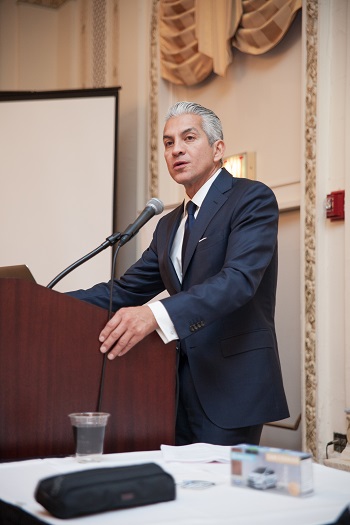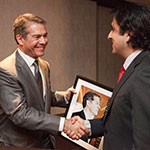There’s work to be done for Latinas in America, and Eva Longoria is taking a leading role in the job.
The spike of a black, stiletto pump peeks out of the front row of steel folding chairs. In the cafeteria of Animo Locke Tech Charter High School, its owner sits among parents anxiously awaiting a graduation ceremony. Soon they will hold certificates proving their dedication to their children’s education, but first, an honored guest will address them. And while there is sure to be publicity about the shoes the commencement speaker stands in as she approaches the podium, the story less often told is the cause she stands for. It seems all of our most beloved celebrities have come-from-nothing stories to share, whether they involve busing tables for tips or the pursuit of the “big break,” and in that respect, Eva Longoria is no different. In high school she worked at a Wendy’s, and the role that launched her acting career was a spot on the soap opera The Young and the Restless. Less often, however, do we hear about stars who return to their roots for more than a ribbon-cutting and a well-timed photo. In this way, Longoria is a líder.
Emerging as an actress-activist-philanthropist-entrepreneur hybrid, Longoria has demonstrated a rare level of commitment to the Latino community much higher than many of her contemporaries would dare, or have the political awareness, to reach. Through the Eva Longoria Foundation she is attacking the cycle of Latino poverty. As a coadviser on immigration to President Barack Obama, she took a stand on one of the nation’s most contested issues and publicly stated as much in her speech at the 2012 Democratic National Convention. Too tenacious to be relegated, too informed to be ignored—and now with a master’s degree in Chicano studies to prove it—Longoria’s heart isn’t bleeding for Latinas. It’s suiting up for a fight.

There are obstacles as a ninth-generation Latin American Longoria herself did not have to face, but which hinder many of the Latinas she meets through her foundation. She joked at the 2013 Women in the World conference that her family didn’t cross the border; “the border crossed us,” she says. In seriousness, however, Longoria admits that she was raised a very “assimilated” Latina, not even learning Spanish until later in life. But perhaps the greatest factor differentiating her from the women and girls whose success she has made her priority, is her family.
“Growing up, I didn’t have to look far for good role models,” Longoria says of the 10 educated women who surrounded her in her youth. She credits her mother and nine aunts—many of them teachers—for instilling in her both an appreciation and desire for education. Although the means may have been uncertain, the end of a college degree was never in question for Longoria. But for many Hispanics, particularly girls, secondary education is not even a prospect. For Longoria, that became all too evident when she once asked a Latina child what she wanted to be when she grew up. To the girl’s response of technical assistant, Longoria said, “Instead of working for an engineer, why don’t you be that person?” “Can I be that person?” she asked Longoria with genuine disbelief.
The achievement gap between Hispanics and their non-Hispanic peers in education is one element of the equation that contributes to the impoverished status of 12 million Latinos living in the United States as of 2009. The National Council of La Raza (NCLR) reports that in 2010 “only 55.5 percent of Hispanic students graduated from high school in four years,” and “14 percent of Hispanics age 25 and older held a bachelor’s degree.” The U.S. Department of Education has confirmed that a bachelor’s degree resulted in earnings for young adults more than twice as high as those without a high school diploma or its equivalent in 2010. The bottom line for Hispanics then, as Longoria understands, is that poverty must be addressed in the classroom.
Partnering with UCLA professor Patricia Gándara to conduct a study on Latina academic performance, Longoria found that the same barriers that impeded the women and girls of her community 30 years ago still stand in their way today. “It was surprising, but also not surprising,” says Longoria, who wanted to identify the successes in Latina education and replicate them. The study, “Making Education Work for Latinas in the United States,” suggests that extracurricular activities are an important factor in Latina student achievement, but also that Hispanic young women are positively influenced by Latina figures of authority in whom they can see themselves reflected. “Those things are easy remedies,” says Longoria with optimism. “We can make a difference right now.”
Because Longoria knows those reflections start at home, you’ll find her sitting among PIQE’s graduating classes as she did at Animo Locke Tech. PIQE, the Parent Institute for Quality Education, is one benefactor of Longoria’s foundation and teaches parents how to engage in their children’s education and hold educators accountable. While the program has a direct correlation to student success—children of graduates have a high school graduation rate of 90 percent—for some Latino parents, it is just as impactful.
“We had a parent who graduated and was crying over the little certificate we give them at the end of class,” Longoria recalls. “It was the only diploma she’d ever received because she never completed more than a third-grade education.”
The lack of education among Latina women poses problems in the entrepreneurial arena as well—a second front on which Longoria is confronting Latino poverty. Latinas are showing the ambition to open their own businesses at six times that national rate, and Longoria herself is a testament to that statistic. As the author of a best-selling cookbook, restaurateur, producer, and owner of her own company, UnbeliEVAble Entertainment, Longoria reflects the ambition of the women she says are primed to be the next force of change in the United States.
“Some of the greatest changes we’ve seen in our country came from ordinary people who saw injustice and wanted it corrected.”
Unlike Longoria, however, many Latinas lack the critical resources to sustain them. It may be the capital to invest in inventory or the technical training in marketing or bookkeeping that keep a Latina entrepreneur’s dreams one step from fruition. To that end, Longoria’s foundation has provided microloans that have allowed Latinas to go from selling Avon products to designing their own fashion lines.
“One thing I try to promote in both the educational and entrepreneurial spheres of the foundation is to make sure Latinas get careers, not just jobs,” Longoria says. “When they develop themselves, they can not only do well for themselves, but have a social impact as well.”
Positioning Latinas for success, Longoria believes, will help them direct the charge out of poverty, one family at a time. “There’s a myth that you have to be rich to make a difference, and that’s just not true,” she says. “Some of the greatest changes we’ve seen in our country came from ordinary people who saw injustice and wanted it corrected.” Longoria’s approach is perhaps the most effective aspect of her philanthropy, and a philosophy mirrored by her mentor, Howard Buffett. A partner in her foundation, Buffett believes one can’t just put a bandage on a global problem with aid. Change must be sustainable that a country or community can maintain itself. “To me, that is so remarkable and respectable,” Longoria says.
Buffett and Longoria also agree that the US’s economic success is reliant on educating Latino youth, an argument Longoria has made to those decision makers less moved by the social woes of her community. Considering projections that Hispanics will constitute nearly a third of the population—therefore sizeable buying power—by mid-century, they have a point.
But Latinos are more than numbers on a spreadsheet or ballots in a box, and Longoria knows this as well, which is why she and others such as Henry R. Muñoz III and Andrés W. López, two coadvisers who served with her on the Obama campaign, have refocused their efforts post-election on the creation of a Smithsonian museum dedicated to Latinos. “Whether as soldiers who’ve fought for our country or dynamic businesspeople who’ve been integral to our economy,” Longoria says, “we [Latinos] are part of the thread of what makes up America. At the National Museum of the American Latino we’d have a place to tell that story.”
In the political arena, Longoria’s schedule may have thinned since the president’s reelection, but she remains active through two of the nation’s most powerful Hispanic advocacy groups. “Both The Mexican American Legal Defense and Educational Fund, on which I am a member of the board, and NCLR with whom I work closely, are at the forefront of immigration reform,” she says. “I don’t need to be appointed or elected to make a difference, so I’ll continue to work with them to realize that goal.”
Though her contributions have been many and have opened doors for Latinas, Longoria herself faces a different kind of exclusion despite her success. “The most significant thing about being an actress is that it has given me a platform to educate and spread awareness to causes that are important to our community,” she explains, “but when I get into political advocacy, my occupation as an actress somehow poses a problem.” Vying for legitimacy will continue to require more of the star of Desperate Housewives fame, but it’s a challenge she has embraced.
“I take a lot of pride in my education and being civically engaged as an American,” she says. “It’s been a journey for me, but a really fun one. I feel like I haven’t even tapped into the potential I have as a human being.”
One thing Longoria believes that inspired her return to graduate school is that you can’t know where you’re going without knowing where you’ve been. Longoria is proving there’s a leader in every Latina, and no matter where her career takes her next, the future is looking bright for those touched by her advocacy.

